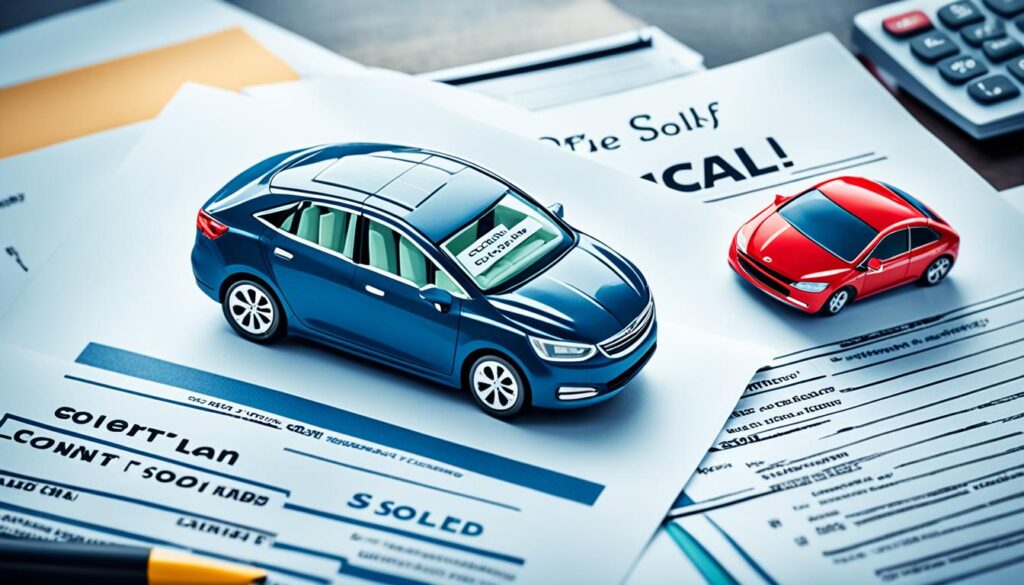how to sell a car with a loan : Selling a car with a loan may require additional steps and considerations compared to selling a car that is fully paid off. It’s important to understand the process and requirements set by your lender to ensure a smooth sale. In this article, we will provide you with practical tips and guidance on how to sell a car with a loan, including determining the payoff amount, assessing your equity, finding a buyer, and navigating the sale process. We will draw information from various sources to present you with comprehensive and accurate information.
Key Takeaways:
- Understanding your loan agreement and the lender’s requirements is crucial when selling a car with a loan.
- Determining the value of your car using reputable pricing guides will help you determine your equity.
- If you have positive equity, you can sell your car in a private sale or consider trading it in at a dealership.
- If you have negative equity, you’ll need to cover the difference between the sale price and the loan balance.
- Maintain open communication with your lender throughout the selling process to ensure a smooth transaction and proper transfer of ownership.
Understanding the Loan and Ownership
When you have a loan, the lender holds a stake in the ownership of the vehicle. The lender’s name may be listed on the car title or they may physically hold the title until the loan is paid off. This is to ensure that the lender can recover their money before the vehicle is transferred to a new owner. It’s crucial to understand your loan agreement and the lender’s requirements regarding the sale of the car. This includes knowing the payoff amount, the process of transferring the title, and any specific instructions given by your lender.
Did you know?
When you sell a car with a loan, the lender has a vested interest in the transaction. They want to make sure their money is recovered before you transfer ownership to someone else.
Loan Balance and Payoff Amount
To sell a car with a loan, you need to be aware of your loan balance and payoff amount. The loan balance is the total amount you owe on the loan, while the payoff amount is the outstanding balance plus any fees or interest that may apply if you decide to pay off the loan early. Understanding these figures will help you determine the selling price needed to cover the loan and ensure a smooth transfer of ownership.
Title Transfer Process
During the sale of a car with a loan, the title transfer process becomes an important consideration. The title serves as proof of ownership, and it needs to be transferred to the buyer once the loan is settled. Depending on your lender’s requirements, the title may be physically held by the lender, with instructions on how to transfer it once the sale is complete. It’s important to follow these instructions carefully to ensure a legal and valid transfer of ownership.
| Common Lender Requirements | Description |
|---|---|
| Payoff Verification | Lenders may require a payoff verification to ensure the correct loan amount is settled. |
| Release of Lien | Some lenders may require a release of lien document to remove their claim on the car’s title. |
| Power of Attorney | In some cases, the lender may require a power of attorney to transfer the title on their behalf. |
Communication with Your Lender
Throughout the selling process, it’s essential to maintain open communication with your lender. Notify them of your intent to sell the car and inquire about any specific requirements or paperwork they may need. This proactive approach ensures that you have all the necessary documentation and information to complete the sale smoothly. Additionally, by keeping your lender informed, they can provide guidance and support as you navigate the loan settlement and title transfer process.
| Key Points |
|---|
| A car with a loan means the lender has a stake in the ownership of the vehicle. |
| Understand the loan agreement and the lender’s requirements regarding the sale. |
| Know the loan balance and payoff amount to set the selling price. |
| Follow the lender’s instructions for transferring the title to the buyer. |
| Maintain open communication with your lender throughout the process. |
Determining the Value of Your Car
Before selling your car with a loan, it’s essential to determine its current value. This will provide you with a baseline for establishing a fair price and understanding your equity position. To accurately assess the value of your car, you can refer to reputable pricing guides such as the Kelley Blue Book or Edmunds.
The Kelley Blue Book is a trusted resource that provides comprehensive pricing information for new and used vehicles. It takes into account various factors including the make, model, mileage, and condition of your car to determine its market value. By inputting these details into the pricing guide, you can obtain the private party sale value and trade-in value of your vehicle.

The private party sale value represents the price that you might expect to receive when selling your car to an individual buyer. It is typically higher than the trade-in value offered by dealerships, as private buyers are often willing to pay a premium for a well-maintained vehicle. On the other hand, the trade-in value represents the amount that a dealership is willing to offer you for your car as a credit towards the purchase of a new vehicle.
Knowing the value of your car will not only help you set a realistic asking price but also determine if you have positive equity or negative equity. Positive equity means that your car’s value exceeds the remaining balance on your loan, while negative equity indicates the opposite. Your equity position will impact the overall sale process, so it’s crucial to have a clear understanding before proceeding.
Once you have determined the value of your car, you can confidently move forward with selling it, whether through a private party sale or a trade-in at a dealership. In the next section, we will discuss how to assess your equity and navigate the sale process based on your equity position.
Assessing Your Equity
Equity plays a crucial role in determining the outcome of selling a car with a loan. Understanding whether you have positive equity or negative equity will guide your decision-making process and help you navigate the sale effectively.
Positive equity occurs when the value of your car is higher than the remaining balance on your loan. This means you have equity that can potentially be used to cover the loan balance and even make a profit from the sale.
Negative equity, on the other hand, arises when the value of your car is lower than the loan balance. In this situation, you’ll need to pay the difference between the sale price and the loan balance to fully settle your loan.
| Equity Status | Definition |
|---|---|
| Positive Equity | Value of the car > Loan balance |
| Negative Equity | Value of the car |
To assess your equity accurately, you’ll need to determine the value of your car and the payoff amount on your loan. This information will help you understand your financial position and plan your next steps accordingly. It’s recommended to consult reliable pricing guides and communicate with your lender to gather the necessary information.

Assessing your equity is vital as it provides a clear picture of your financial obligations and potential gains from the sale. Whether you have positive equity or negative equity, being aware of your equity status will enable you to make informed decisions and effectively manage the transaction.
Selling a Car with Positive Equity
When selling a car with positive equity, the process becomes simpler and more advantageous for you. In a private sale, the buyer will pay the agreed amount, which covers the loan balance and leaves you with additional funds as profit. The title transfer is a crucial step in completing the sale. Both you and the lender will sign the title, ensuring a smooth transfer of ownership to the buyer. The buyer can then proceed to register the car and obtain a new title in their name.
Consider the option of taking an unsecured personal loan to cover the entire amount owed on the car before selling it. By doing so, you achieve sole ownership of the vehicle, which can potentially increase your negotiation power and enable you to sell the car at a higher price.
If you decide to go down this route, it’s important to choose a reputable lender offering favorable terms and interest rates. Take the time to compare loan options and evaluate the financial implications before making a decision.
Note: Taking an unsecured personal loan is a personal financial decision that should be carefully considered. It’s recommended to consult with a financial advisor or mortgage specialist to understand the terms and potential impact on your overall financial situation.
Now, let’s take a look at a comprehensive table summarizing the steps involved in selling a car with positive equity:
| Step | Description |
|---|---|
| Determine the positive equity amount | Calculate the difference between the value of your car and the remaining loan balance. |
| Find a potential buyer | Advertise your car’s sale and negotiate a mutually agreed-upon price. |
| Prepare necessary paperwork | Ensure all documentation, such as the bill of sale, is complete and accurate. |
| Schedule the title transfer | Coordinate with the buyer and lender to sign the title and transfer ownership. |
| Receive the buyer’s payment | Confirm that the buyer pays the agreed amount, covering the loan balance. |
| Release the title to the buyer | Provide the buyer with the signed title, allowing them to register the car in their name. |
By following these steps and considering the option of an unsecured personal loan, you can successfully sell your car with positive equity, ensuring a smooth transaction and a beneficial financial outcome.
Selling a Car with Negative Equity
When selling a car with negative equity, you face the challenge of owing more on the loan than the car’s current value. In this scenario, the buyer will pay the purchase amount, but you’ll still need to cover the difference between the sale price and the remaining loan balance. This means you’ll have to repay the lender to obtain the title and transfer it to the buyer.
Alternatively, you can explore the option of taking out an unsecured personal loan to bridge the gap between the sale price and the loan balance. However, it’s important to carefully assess the financial implications of this decision, as unsecured personal loans typically come with higher interest rates.
Before proceeding with a sale when you have negative equity, it’s crucial to consider the potential impact on your finances and weigh the costs and benefits of different options available to you.

Private Sale with Negative Equity
| Key Considerations | Explanation |
|---|---|
| Loan Balance | The amount of money remaining on your car loan that needs to be paid off. |
| Sale Price | The agreed-upon price at which you sell the car to the buyer. |
| Negative Equity | The difference between the sale price and the loan balance, indicating the amount you’ll need to repay to the lender to obtain the title. |
| Repayment Options | Explore repayment options, including using existing funds or taking out an unsecured personal loan to cover the negative equity. |
| Financial Implications | Assess the impact of negative equity on your overall financial situation, considering interest rates and long-term financial goals. |
Trading in a Car with a Loan
Another option for selling a car with a loan is to trade it in at a dealership. This allows you to simplify the process by combining the sale and purchase into one transaction. Here’s how it works:
- The dealership will assess the value of your car, considering factors such as its make, model, mileage, and condition.
- Based on their evaluation, the dealership will offer you a trade-in credit, which can be used towards the purchase of a new car.
- If you have positive equity in your current car, meaning its value exceeds the remaining loan balance, the trade-in credit can act as a down payment for your new vehicle.
- However, if you have negative equity, meaning the loan balance is higher than the car’s value, the remaining loan balance will be rolled over into your new car loan.
It’s important to understand the terms and conditions of the trade-in offer and consider the long-term financial implications. If you have positive equity, trading in your car can help reduce the loan amount for your new vehicle and potentially lead to a lower monthly payment. On the other hand, if you have negative equity, rolling over the remaining loan balance can increase the overall loan amount, resulting in higher monthly payments.
Benefits of Trading in a Car with a Loan
Trading in a car with a loan offers several advantages:
- Convenience: By trading in your car at a dealership, you can streamline the selling and buying process, saving time and effort.
- Simplified Financing: If you have positive equity in your current car, the trade-in credit can serve as a down payment for your new vehicle, simplifying the financing process.
- One-Stop Shop: Dealerships often have a wide selection of new and used cars, providing you with various options to choose from.
- Expert Advice: Dealership representatives can offer guidance and assistance throughout the trade-in and purchase process, helping you make informed decisions.
Overall, trading in a car with a loan can be a convenient option if you’re looking to upgrade your vehicle. However, it’s crucial to carefully consider your equity position and review the terms of the trade-in offer to ensure it aligns with your financial goals.
| Pros | Cons |
|---|---|
| Convenience of combining the sale and purchase | Potential increase in overall loan amount if you have negative equity |
| Simplified financing process | May limit your options to a specific dealership’s inventory |
| Expert guidance and assistance from dealership representatives | Potential for lower trade-in value compared to a private sale |
Note: The pros and cons listed above are general considerations and may vary depending on your specific situation and the dealership’s trade-in offer.

Interacting with Your Lender
When selling a car with a loan, it is crucial to maintain open and clear communication with your lender throughout the entire process. By notifying your lender of your intention to sell the car, you can ensure they are aware of the upcoming transaction and provide you with any specific instructions or requirements they may have.
One of the primary aspects of interacting with your lender is understanding the loan payoff process. This involves determining the exact amount required to settle the loan in full, including any accrued interest or fees. By obtaining this information from your lender, you can properly calculate the necessary funds to complete the sale.
In addition to the loan payoff process, your lender may also require certain documentation to facilitate the transfer of ownership. These documents could include a release of lien or title transfer forms. It is important to inquire about these requirements directly with your lender to ensure you have all the necessary paperwork in order.
By following the guidance provided by your lender, you can ensure a smooth transaction and the proper transfer of ownership. Remaining in constant communication with your lender throughout the selling process will help you stay informed and address any queries or concerns that may arise.
Sample Table: Lender Communication and Documentation Checklist
| Steps | Actions |
|---|---|
| 1. Notify your lender | Contact your lender to inform them of your intention to sell the car. Provide them with the necessary details and request any specific instructions. |
| 2. Inquire about loan payoff process | Ask your lender for the exact amount required to settle the loan, including any additional fees or accrued interest. |
| 3. Understand necessary documentation | Check with your lender to determine the specific paperwork they require for the transfer of ownership, such as a release of lien or title transfer forms. |
| 4. Maintain open communication | Stay in regular contact with your lender throughout the selling process to address any questions or concerns that may arise. |
Sample Quote:
“Maintaining open communication with your lender is crucial when selling a car with a loan. Notifying them of your intention to sell and understanding their requirements will help ensure a smooth transaction and the proper transfer of ownership.”
Tips for Selling a Car with a Loan
Selling a car with a loan may raise concerns for potential buyers. To address their concerns and build buyer confidence, it’s essential to take necessary precautions and provide transparency throughout the sale process.
Private sale precautions:
- When listing your car for sale, you don’t need to disclose loan information upfront. However, it is important to inform serious buyers about the loan situation before proceeding with the sale to avoid any misunderstandings. Be transparent and explain the necessary steps involved, including title transfer and loan payoff.
Bank involvement:
Consider involving a bank or a recognized financial institution in the sale process to give buyers confidence that everything is being done correctly. The bank’s involvement can provide an extra layer of trust and assurance for both parties involved.
Loan information disclosure:
“I had a great experience selling my car with a loan. I informed potential buyers about the loan situation, and the bank’s involvement gave them confidence in the process. It was a smooth transaction, and I highly recommend being transparent about the loan before finalizing the sale.” – John Doe, car seller
By presenting the loan information upfront and explaining the necessary steps involved, you can minimize buyer objections and facilitate a smooth transaction.
| Tips for Selling a Car with a Loan: | Benefits: |
|---|---|
| Be transparent about the loan situation | Builds buyer confidence and trust |
| Inform serious buyers about the necessary steps | Minimizes buyer objections |
| Consider involving a bank or recognized financial institution | Provides additional assurance for buyers |
Selling a Car with an Online Lender
If your car loan is from an online lender, there may be additional steps involved in the sale process. Some online lenders require the full loan balance to be paid before they release the title. In these cases, you have a couple of options to consider:
- Arranging for the buyer to make the payment directly to the lender.
- Facilitating a direct payment if there is a close relationship between you and the buyer.
While these options provide a solution, it’s important to note that they may deter some buyers who are unfamiliar with the process and prefer a more traditional transaction. Building trust and providing clear instructions will be crucial in successfully selling a car with an online lender.

| Challenges | Potential Solutions |
|---|---|
| Online lenders may require full loan balance payment before releasing the title. |
|
| Buyers unfamiliar with the process may prefer a more traditional transaction. |
|
Addressing these challenges and reassuring potential buyers can help you navigate the sale process successfully and sell your car with an online lender.
Preparing for the Sale
When selling a car with a loan, there are several key steps you need to take to ensure a successful sale. Preparing for the sale involves creating an attractive car listing or advertisement, negotiating with potential buyers, and ensuring all necessary paperwork is complete. Let’s explore each of these steps in detail.
Creating a Car Listing or Advertisement
One of the first things you’ll need to do is create a compelling car listing or advertisement that accurately represents your car’s value and condition. Be sure to include detailed information about your car, such as its make, model, year, mileage, and any notable features. You should also include clear and high-quality photos of your car from different angles to attract potential buyers.
When writing the description, highlight the key selling points of your car, such as its excellent condition, low mileage, or any recent upgrades or maintenance that has been done. It’s important to be honest and transparent about any existing issues or cosmetic flaws to avoid any surprises for the buyer.

Negotiating with Potential Buyers
Once you start receiving inquiries from potential buyers, be prepared to negotiate the price. Research market trends and comparable listings to set a competitive price for your car. Consider factors such as the make, model, year, mileage, condition, and any additional features your car may have. Be open to offers and willing to discuss the price to attract serious buyers.
During negotiations, emphasize the value of your car and address any concerns or questions the buyer may have. Be patient and willing to compromise, but also know your bottom line and be prepared to walk away if an agreement cannot be reached.
Completing the Necessary Paperwork
Once you’ve found a buyer and agreed on a price, it’s important to ensure that all necessary paperwork is complete and that the transaction is legally binding. This includes providing a bill of sale, which outlines the specific details of the sale, such as the buyer and seller’s information, the agreed-upon price, and the date of sale.
Also Read : how to get a startup business loan with no money
In addition to the bill of sale, you’ll need to transfer the title to the new owner according to your lender’s instructions. This typically involves contacting your lender to obtain the necessary paperwork and following their specific guidelines for transferring the title.
| Required Documents | Notes |
|---|---|
| Bill of Sale | Includes buyer and seller information, sale details |
| Title Transfer | Follow lender’s instructions for transferring the title |
Completing all the necessary paperwork ensures a smooth and legal transfer of ownership, protecting both you and the buyer.
By following these steps and adequately preparing for the sale, you can increase your chances of selling your car with a loan successfully. Remember to create a compelling listing, be open to negotiations, and complete all the necessary paperwork to ensure a smooth and legally binding transaction.
Conclusion
Selling a car with a loan may seem daunting, but with careful planning and effective communication with your lender, it can be a successful endeavor. Whether you have positive or negative equity, understanding the value of your car, determining the payoff amount, and working with potential buyers are crucial steps for a smooth and profitable sale.
By following the tips and guidance provided in this article, you’ll be well-equipped with the knowledge and strategies to navigate the selling process confidently. Transparency and adherence to your lender’s requirements are essential in building trust and maintaining a trustworthy transaction.
Remember, selling a car with a loan requires thorough research, understanding your financial situation, and proper documentation. With the right approach, you can achieve a successful sale and move on to your new car or financial goals.
FAQ
Q: How can I determine if I have equity in my car before selling it?
A: You can calculate the equity in your car by subtracting the outstanding loan balance from the current market value of the vehicle. Positive equity means the car is worth more than the loan balance.
Q: Should I refinance my car loan before selling the vehicle?
A: Refinancing your car loan before selling may be beneficial if you can secure a lower interest rate or better loan terms, which could help you pay off the loan faster and potentially sell the car at a higher price.
Q: How can I sell my car privately and pay off the remaining loan?
A: To sell your car privately and pay off the loan, you will need to coordinate with the buyer to ensure the loan is settled before transferring the title. Make sure to communicate with your lender throughout the process.
Q: How can I sell my car with an existing auto loan?
A: To sell a car with a loan, you can either pay off the remaining balance of the loan before selling, or find a buyer who is willing to take over the loan.
Q: What should I do if the car is worth less than the remaining loan amount?
A: If the car is worth less than what you owe on the loan, you may have negative equity. You will need to pay off the remaining balance to the lender before selling the car.
Q: Can I sell my car to a private party even if I still owe money on the loan?
A: Yes, you can sell your vehicle to a private party while you still have a loan. You will need to pay off the loan in full to transfer the title to the new owner.
Q: What are the extra steps involved in selling a car with an outstanding loan?
A: When selling a financed car, you will need to work with the lender to pay off the loan balance, transfer the title, and ensure all legal requirements are met.
Q: Is it possible to pay off a car loan early?
A: Yes, you can pay off your car loan before the end of the loan term. Contact your lender to get the payoff amount and follow their instructions to complete the early payment.
Q: What should I do if I want to sell a car that I still owe money on?
A: If you want to sell a car with an existing loan, you will need to pay off the loan balance before transferring ownership to the new owner.
Q: How can I sell my car to a private party?
A: To sell your vehicle to a private party, you will need to find a buyer, agree on a price, pay off the loan (if applicable), transfer the title, and complete all necessary paperwork.
